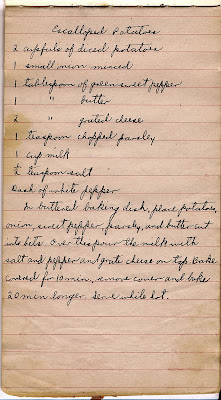I learned a lot about potatoes when I attended a presentation last week at the New York State Museum. Dr. Roland Kays, a scientist at the Museum, and Chef David Britton of The Food Network collaborated on presenting an entertaining and informative session complete with free food samples. Much of the information they presented was drawn from a fascinating book, Potato: A History of the Propitious Esculent, by John Reader.
 |
| Varieties of potato |
The starchy tubers apparently found their way to Europe on Spanish ships as early as 1567. One of the earliest written indications of their presence in Spain is a notation in the records of a hospital in Sevilla in 1573, for the purchase of 19 pounds of potatoes.
This cheap food was quickly adopted by those on the lower rungs of society, due in part to its nutritional value and the ease with which it could be propagated. As a tuber (a fleshy underground plant stem), the potato stores nutrients that help the plant survive long dry or cold seasons. These nutrients also make it an important food source for humans. One medium-sized potato contains about 110 calories, no fat, and also provides a substantial portion of the daily need for Vitamin C, Vitamin B6, and potassium, as well as trace amounts of niacin, thiamin, riboflavin, magnesium, phosphorus, iron, and zinc.
In fact, two to three kilograms of potatoes per day served with a bit of milk, butter, and salt can enable a person to survive for months on this admittedly monotonous diet. The potato became so popular in Europe that by the mid-19th century, millions counted it as the basis of their diet. But since so many of the potatoes cultivated were basically cloned through vegetative propagation, there was very little genetic diversity in the tons of tubers being grown and consumed.
 |
| Potato ruined by blight |
The potato also became an important part of the diet of the Dutch and Germans, including many who also emigrated to the New World. And so the potato found its way to Upstate New York. Both of my cookbooks contain recipes for preparing potatoes. My mother used to make "scalloped potatoes." Grandma Minnie's recipe calls this dish "escalloped potatoes," perhaps an older form closer to the original French from whence the word came. As you might guess, the word is related to "scallop," and refers to cutting meat -- or potatoes in this case -- into thin slices like shells -- scallop shells, of course.
This recipe actually calls for diced potatoes, not thin slices like shells. But notice the milk, butter (and a bit of grated cheese), which not only make the dish tasty, but hearken back to the peasant diet mentioned earlier. Here the simple dish is dressed up a bit by adding onion, green pepper (I added red too for color!), and parsley.
The recipe calls for diced potatoes, not thin slices as my mother used to do. But maybe I cut the "dice" too large, more like ice cubes than dice. So they didn't cook thoroughly at 325 - 350 F. in 30 minutes as the time suggested on the page. I had to stick the dish in the microwave for an additional five minutes.
It had a good flavor anyway, so good in fact that we almost "licked the platter clean," although I doubled the amount of potatoes called for. . . And although my husband almost always adds salt to anything I cook and my son always adds pepper, I didn't add a thing, and I cleaned my plate!
 |
| Escalloped Potatoes |

No comments:
Post a Comment
Note: Only a member of this blog may post a comment.